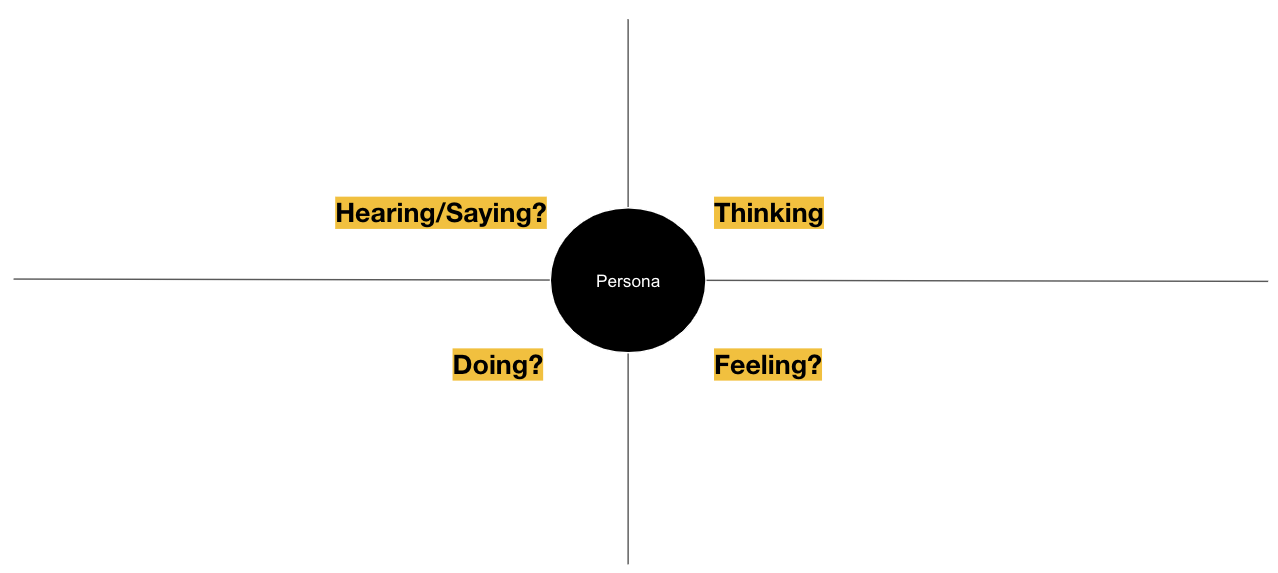Designing with User-Centred Focus: How Empathy Mapping Can Help
As user experience designers, it’s easy to get caught up in our own ideas and assumptions about what our users want and need. We may create solutions that we think are the best fit for their needs, but how can we be sure that we’re designing with their best interests in mind? The answer lies in empathy mapping.
Empathy mapping is a design thinking technique that helps us to understand our users’ needs, wants, and pain points. It allows us to create user-centred designs that truly meet their needs, and as a result, are more effective in achieving our goals.
What is Empathy Mapping?
Empathy mapping is a visual tool that helps designers gain a deeper understanding of their users by focusing on four key areas:
- What the user sees: This includes the user’s physical environment, what they are reading, and what they are looking at. Think about context here.
- What the user hears: This includes the user’s internal and external conversations, as well as what they are listening to.
- What the user thinks and feels: This includes the user’s beliefs, values, and emotions. Empathy really comes to life here.
- What the user says and does: This includes the user’s actions, behaviours, and communication.

It helps designers to test their assumptions. By creating an empathy map, designers can test their assumptions about the user and get feedback on their designs. Empathy mapping helps designers to create a detailed profile of the user, and to see things from their perspective. By doing this, we can better understand the user’s needs, goals, and motivations, and design tailored solutions.
Why is Empathy Mapping Useful in the Design Process?
Empathy mapping is a powerful tool for several reasons:
- It helps designers to think more deeply about their users and their needs. By focusing on the user’s perspective, designers can create more user-centred designs that are more effective in achieving their goals.
- It helps designers to identify and prioritise features that are important to the user. By understanding the user’s goals and motivations, designers can create solutions that are tailored to their needs.
- It helps designers to communicate with their teams and stakeholders. Empathy maps are visual and easy to understand, making them a great tool for communicating the user’s needs to others.
- It helps designers to test their assumptions. By creating an empathy map, designers can test their assumptions about the user and get feedback on their designs.
Empathy mapping is a great tool for designers who want to create user-centred designs that truly meet the needs of their users. By understanding the user’s perspective, designers can create solutions that are more effective in achieving their goals, and that ultimately result in a better user experience.
How to Create an Empathy Map?
Creating an empathy map is relatively easy as a practical tool, and can be done in a few simple steps:
- Identify your user persona: Who is your target user?
- Define the scenario: What is the context of use? What are the user’s goals?
- Fill in the empathy map: Use the four key areas of the empathy map to create a detailed profile of the user. You can use post-it notes or a digital tool like Figjam to create the map.
- Analyse and prioritise: Analyse the empathy map to identify the user’s pain points, goals, and motivations. Prioritise the most important features and design solutions that meet their needs.
In conclusion, empathy mapping is a powerful tool for user experience designers and product designers who want to create user-centred designs that meet the needs of their users. By focusing on the user’s perspective, these designers can create solutions that are more effective in achieving their goals, and that ultimately result in a better user experience.
If you’re a designer who hasn’t tried empathy mapping yet, try it and see how it can transform your design process. Come along to one of our empathy mapping workshops to see how this all comes together and to try your hand at creating one.


